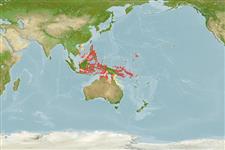Environment: milieu / climate zone / depth range / distribution range
Ökologie
seewasser riff-verbunden; tiefenbereich 3 - 30 m (Ref. 90102), usually 10 - 20 m (Ref. 27115). Tropical; 22°C - 28°C (Ref. 27115); 21°N - 27°S, 109°E - 168°E
Western Central Pacific: Philippines south to the Solomon Islands. Absent from Australia.
Size / Gewicht / Alter
Maturity: Lm ? range ? - ? cm
Max length : 34.0 cm TL Männchen/unbestimmt; (Ref. 9710)
Rückenflossenweichstrahlen (insgesamt) : 72 - 79; Afterflossenweichstrahlen: 54 - 62.
Inhabits shallow lagoon and coastal reefs (Ref. 9710, 48635). Forms schools that are often found under ledges or around coral heads (Ref. 9710). Swim in tight formation to look like a single large body (Ref. 48635). Juveniles resemble the venomous striped catfish Plotosus lineatus. Adults live secretively in reefs and have a barred or spotted color pattern (Ref. 48635).
Life cycle and mating behavior
Geschlechtsreife | Fortpflanzung | Ablaichen | Eier | Fecundity | Larven
Nelson, J.S., 1984. Fishes of the world. 2nd edition. John Wiley & Sons, Inc., New York. 523 p. (Ref. 245)
IUCN Rote Liste Status (Ref. 130435: Version 2024-1)
Bedrohung für Menschen
Harmless
Nutzung durch Menschen
Fischereien: nicht kommerziell; Aquarium: Kommerziell
Tools
Zusatzinformationen
Download XML
Internet Quellen
Estimates based on models
Preferred temperature (Ref.
123201): 26.9 - 29, mean 28 °C (based on 162 cells).
Phylogenetic diversity index (Ref.
82804): PD
50 = 1.0000 [Uniqueness, from 0.5 = low to 2.0 = high].
Bayesian length-weight: a=0.00389 (0.00180 - 0.00842), b=3.12 (2.94 - 3.30), in cm total length, based on all LWR estimates for this body shape (Ref.
93245).
Trophic level (Ref.
69278): 3.5 ±0.5 se; based on size and trophs of closest relatives
Fishing Vulnerability (Ref.
59153): Low vulnerability (24 of 100).
Nutrients (Ref.
124155): Calcium = 68.3 [37.8, 101.5] mg/100g; Iron = 0.625 [0.396, 1.013] mg/100g; Protein = 18.6 [17.6, 19.6] %; Omega3 = 0.0822 [, ] g/100g; Selenium = 38.2 [20.3, 69.8] μg/100g; VitaminA = 64.5 [23.0, 176.2] μg/100g; Zinc = 1.49 [1.06, 2.03] mg/100g (wet weight);
